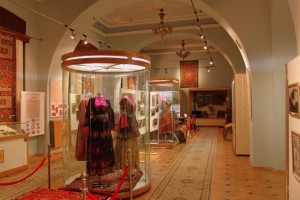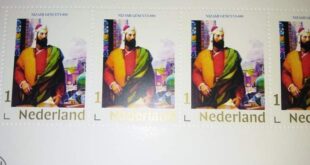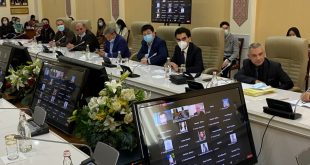
Azerbaijan history museum
Azerbaijan history museum is created in 1920. The museum has 8 sections, 2 laboratories, 11 funds, scientific archive and library. The exposition of the museum is situated in 35 halls. The scientific fund of the museum has over 300 thousand different exhibits. History and culture of Azerbaijan have reflected since ancient period before our days here. In the hall of the museum “People’s friends and employees” is presented exhibits of friendly people, gifts from foreign states, are demonstrated rare pearls. There are scientific works, monographs, albums-catalogues, exposures, booklets and
others in the museum.
Memorial museum of Mammad Said Ordubady
The memorial museum of the famous Azerbaijan writer, playwright and journalist – M.S.Ordubady was founded on October 31 1979 after the decree of Council of Ministers of Azerbaijan republic. The museum is placed in the centre of Baku. Here the writer had lived since 1937 till 1980. Being a cultural enlightenment hearth the museum preserves creative heritage of the writer. M.S.Ordubady was born in 1822, Ordubad city. Ordubady lost his father early and began to work in a silk mill at his fourteen.
His first poem was published in 1903. Later he began to publish articles and topical satire in such newspapers as “Irshad”, “Shargy-Rus”, “Taza hayat”, “Ittifag”, “Taraggy”. The exposition of the museum consists of 2 rooms. The first room is the writer’s drawing room and at the same times his study where books, memorabilia of the writer, his documental photos are presented. The view of the room is kept as it was in poet’s life-time. A
noteworthy exhibit of the hall is M.S.Ordubady’s portrait by honored culture worker, artist – Altai Hajiyev. The table presented in the room witnessed the creative process of the writer. Just at this table M.S.Ordubady created his best works “Underground Baku”, “A foughting city”, “A sword and a feather”.
The second room of the exhibition is dedicated to the writer’s creative activity. Here the examples of writer’s works are shown. In exposition there are examples of M.S.Ordubady’s books beginning from his first two books – “The Ignorance”, “The motherland and the freedom” published by “Geyret” publishing house, till his latest novels. The excursions with visitors are lead in Azerbaijanian and Russian.
Museum of Azerbaijan literature named after Nizami Ganjavi
The whole area of the museum is 2500 sg.m. The exposition occupies 1409 sg.m, the scientific funds occupies 173 sg.m. Sculptures of the six famous representatives of Azerbaijan literature: Fizuli (sculptor F.Abdurrahmanov), Vagif (sculptor S.Klyatsky), M.F.Akhundov (sculptor P.Sabsay), Natavan (sculptor E.Tripolskaya), D.Mammedkulizade (sculptor N.Zakharov), J.Jabbarly (sculptor S.Klyatsky) are located on the front side of the museum. The sculptures give the building a pantheon-like appearance. Isrucco moulding, latticed wooden windows, original furniture decorate the halls, where the Museum’s exhibits are displayed.
The memorial museum of literature, presenting Nizami Ganjevi’s epoch, was inaugurated in May 1945 in the festive days of the victories ending of the great Patriotic War. The present-day Museum of the history of Azerbaijan literature based in Nizami Museum and it’s collection of exhibits, was completed in 1967, the exposition was recreated in 2001-2003.
Nizami Ganjavi literary museum is one of the biggest and richest measure-houses of Azerbaijan culture. Valuable materials dealing with the history of Azerbaijan literature beginning from the very sources up to our days are kept in the museum.
Various valuable exhibits are on display in the halls of the museum. There are unique manuscripts of Azerbaijani as well as other Oriental poets, philosophers and scientists, samples of famous calligrapher handwritings, beautiful miniature illustrations, classic’s books, copies of pre-Revolutionary magazines and newspapers, contemporary copies of the books written by Azerbaijani authors and scientific papers in many European and Oriental languages. Also there are documentary photos and pictures, personal things of writers, interesting specimen of folk art, numismatic collections of coins of different epochs found in Azerbaijan, old rugs, various samples of material culture-ceramics bronzes and many other valuable exhibits connected with Azerbaijan people’s culture.
There are above 3000 literary and art exhibits in the 26 halls of the museum. Much attention is given to extracts from books, fragment from works of fiction, quotations of famous writer and scholars, biographic and other explanatory texts. Not all the treasures of the Nizami Museum are displayed in the halls, its fund contains above 75 thousands different exhibits.
The excursions with visitors are lead in Azerbaijanian, Russian, English and Persian languages.
Azerbaijan state museum of carpet and applied arts
Museum of the azeri carpet, folk & applied arts is the first museum of carpets in the world. It is created in 1967, discovered in 1972.
The funds of the museum of Azeri Carpet have over 10 thousand valuable works of art. Carpets weaved in the XIII-XX centuries are objects of the ancient living; Bronze Epoch ceramic monuments and art metals of the XIV century are among them. The high-level mastering can be marked in decorations – silver and gold jewellery, traditional clothes, and art embroidery. There is also a collection with the wide representation of works of modern artists-craftsmen.
The excursions with visitors are lead in Azerbaijanian, Russian, English languages.
House-museum of Samad Vurgun
Samad Vurgun was the scientist, academician of the Academy Sciences of the Azerbaijan SSR. The last years of his life he, took the post of was vice-president of the Academy of Sciences of the Azerbaijan SSR. House-museum of Samad Vurgun, the great Azerbaijan poet, twice State prize winner, well-known playwright, scientist and a notable public figure is the first memorial Museum, established in Azerbaijan. Museum, organized in 1974 by the decree of the Azerbaijan Government, was inaugurated in 6 October 1975.
Nowadays more than 16000 exhibits are kept in the Museum.
Three rooms of the Museum – a study, a drawing room and a bedroom are kept as they were in the poet’s life time.
In this apartment were created plays “Vagif”, “Farhad and Shirin”, “Insan”, poem “Aygyun” and a great
deal another.
In the glass-cases one can see his memorial things: sheepskin coat, fowling-piece, saz and different presents given to the poet.
Twice a year on March 21 and on May 27 is hold as “The Days of Memory” of Samad Vurgun. In the Museum are also being prepared the mobile exhibition. There is a literary circle “Our favorite Poet”, dedicated to Samad Vurgun. S.Vurgun was the first awarded the title of “National Poet of Azerbaijan”.
In the Museum the excursions with visitors are lead in Azerbaijanian and Russian.
Museum of fine arts named after Rustam Mustafayev
Arts Section of Azerbaijan State Museum is created in 1936 (formed in 1920). The section was opened in 1937. Nowadays 12 thousand wonderful art masterpieces are kept in the Museum. The exposition of the museum is situated in 42 rooms.
Arts museum is the treasure of Azeri, Russian, and West-European art works. It also contains incredible works of art of the East: Turkey, Iran, Japan and China. The museum tells about artists and the skills of the unique craftsmen of the XVIII-XX centuries in Azerbaijan.
Widely presented are the works of the matters of modern decorative and applied art in the museum. There are carpets made by A.Karimov and K.Aliyeva; tapestries of F.Huseinova, U.Gamidova, T.Afababayeva; large felt mats of R.Ismailova, and ceramics of M.Avshara, N.Sultanova. The masterpieces of people’s decorative andapplied art are: carpets, embroideries, textiles, clothes, fretwork in stone, wood and metal, pottery and jewelry.
Memorial museum of Nariman Narimanov
The memorial museum of the famous playwright and Doctor Nariman Narimanov was opened on November 6 in 1977.
The Museum is located at the house, which had been built by the project of architect M.M.Ismaylov and belonged to the merchant Babayev.
On the second floor of this house Nariman Narimanov had lived with his family since 1913 up to 1918. The exposition of the museum is situated in 4 rooms: the dining-room, living-room, bedroom and a study. The common area of the exposition is 96 sg.m.
In the first room we could get information about his youth-ages, his study in famous Gori seminary and his activity as a teacher by means of writer’s rare family photos, and some state documents.
In the second room there are materials about Narimanov’s study at the Medical Institute in Odessa. The third room is kept as it was during Narimanov’s life-time. Here you can see some memorial things of the writer.
In the fourth room you can see the study of the writer, his medical cupboard, the stand, and his medical instruments.
The most seminal period in Narimanov’s creative activity is a last decennial event of the XIX centure. In this time he wrote the history drama “Nadirshah”, comedy “Shamdan-bek”, play “Ignorance”, novel “Bahadur and Sona”.
More than 5000 exhibits, publication of books, original photos, autographs, genealogy of the Narimanov’s is kept in the fund of the museum. Narimanov’s day of birthday and the most noteworthy days of his creative activity are celebrated in the museum every year.
In the museum the excursions with visitors are lead in Azerbaijanian and Russian.
House-museum of Jalil Mammadguluzade
The decree about the foundation of the J.Mammedguluzade’s house museum was issued in 1978. But the museum was inaugurated on 29 of December in 1994, after Haydar Aliyev’s decision about the celebration of poet’s 125th birthday anniversary.
In a scientific fund of the museum more than 3000 exhibits are kept, 500 of them are in exposition. The exposition of the museum consists of 5 rooms of the house with the whole area 125 sq.m.
The first room of the exposition lightens the childhood, youth-ages and his period of study. The second room is memorial drawing-room of the writer. In this room there are illustrations made by Azeri illustrator-artist on the theme of Jalil Mammedguluzade’s stories. The third room is the writer’s memorial bedroom with corresponding interior and furniture.
The forth room of the exhibition gives us information about creative activity of the writer by means of family photos, books and historical documents. Right in this room one can see some illustrations devoted to the journalistic activity of J.Mammedguluzade, particularly interesting are those dealing with “Molla Nasraddin” magazine’s issues in Tebriz and Tiflis.
The fifth room is the poet’s study and at the same time it served as editorial office of the magazine “Molla Nasraddin”. The exhibits are presented in this room reproduces the activity period of “Molla Nasraddin”; in 1923- 32, shows us literary environment of that time.
In the museum J.Mammedguluzade’s Memory Days are celebrated annually.
House-museum of Huseyn Javid
The house-museum of the famous poet – philosopher, playwright Huseyn Javid was opened on November 25 in 1981. Working as a teacher in the seminary since 1920 H.Javid lived on the 3 floor of the seminary’s building till June 4, 1937, that is to say, tills his arrest.
The common area of the museum is 245 sq.m. Exposition occupies 130 sq.m., funds – 12 sq.m. A fund of the museum has got 4250 exhibits. The house-museum consists of 4 rooms and a foyer. The foyer begins with the description of the planet named after Huseyn Javid. The model of the monumentto Javid by people’s artist, sculptor O.Eldarov in Baku is presented here. Triptych, created by the people’s artist O.Sadygzadeh introduces visitors with literary heroes Javid’s world.
“Javid’s tragedy”- this is a title of the third room. The things are the same as they were in those days when the poet was alive: writing-table, fragments of letters from exile in Siberia, Sadygzadeh’s illustration devoted to victims of 1937 year repression, Javid’s “Last work”. The documentary photos of bringing back to Baku from Siberia Javid’s corpse, of the process of burying in Nakhchivan are also among the exhibits of the third room.
The publications of his works, play-bills of performances, A.Hajiyev’s illustrations to Javid’s work “The last summer”, artist A.Aliyev’s illustrations to “Iblis” (Demon), artist A.Kerimova’s the carpet and other exhibits are demonstrated in the house-museum of Huseyn Javid.
House-museum of Jafar Jabbarly
The house-museum dedicated to the founder of new period Azerbaijan dramaturgy, poet, translator, scriptwriter J.Jabbarly was opened in connection with 80-th anniversary of Jabbarly’s birthday on March 23, 1982.
The common area of the museum is 200 sg.m. The exposition of the museum is situated in 7 rooms. A fund of the museum has more than 8000 exhibits.
The 1 room of the exposition dedicated to J.Jabbarly’s childhood, youth ages, education, and the early period of his poetical and dramaturgic activity.
The 2 hall – the study has a memorial character. In such a small room the wonderful examples of Azerbaijan dramaturgy had been created by writer.
Exhibits of the 3 hall narrate about romantic period of writer’s activity. The models to writer’s plays “Aydin”, “Ogtay Elogly”, “Od galini” which are famous at the stage of Azerbaijan State Drama Theatre. The exhibits of the IV room show us the musical activity of the writer. There are such musical instrumentsas piano, gramophone, tar.
The most interesting and fruitful period of writer’s life is from 1928 till 1930. Just at that time the remarkable works had been created by Jabbarly as “In 1905”, “Almas”, “Sevil”, the masterpieces of national dramaturgy.
The V room is about J.Jabbarly’s activity as translator and scriptwriter. Translations of world classics’ works as F.Shiller, W.Shakespeare, P.Bomarche, M.Gorky, L.Tolstoy and others belong to his pen. The VI room includes the last period of J.Jabbarly’s life and creative activity. The materials, historical photos, illustrations, last plays of the dramatist as “Yashar”, “Turning point”, the handwriting of unfinished work “Afghanistan” are presented in the exposition.
The VII room is conditionally called “The grief room”. In this room the writer passed away. The excursions are on Azerbaijanian and Russian languages.
 Oval Useful news from Azerbaijan and Caucasus
Oval Useful news from Azerbaijan and Caucasus

